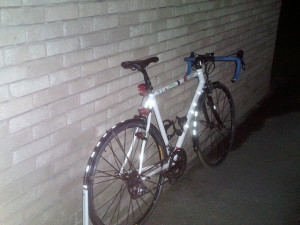Today is the start of that time of year when long summer days turn short with long fall nights. The change may be something you have never thought much about, but it means changes if you are a bike commuter, or if you like evening rides.
![]() Equinoxes mark a change that we see and feel, however gradually: the change in seasons. After today’s autumn equinox, days become shorter as the Northern Hemisphere gets a turn with less direct sunlight in a day.
Equinoxes mark a change that we see and feel, however gradually: the change in seasons. After today’s autumn equinox, days become shorter as the Northern Hemisphere gets a turn with less direct sunlight in a day.
Less light could completely change your daily routine. Here are some ways you can adapt yourself, your bike, and your habits to your surroundings to stay safe cycling in less light.
Make Yourself Visible
Take extra steps to ensure your safety every time you ride in the dark. This includes thinking about what you wear and about what you put on your bike. It may seem excessive to consider every aspect of your getup, but every piece counts if it keeps you visible.
Choosing Your Outfit
If you’re used to riding in broad daylight on a late summer afternoon, you might not have had to worry about light-reflective clothing. After the autumn equinox, however, night could start falling before you start your normal ride. The sun could be completely set before you know it.
That’s why you should always wear bright, reflective clothing when you ride. Wear light colors that stand out against the dark backdrop of the night so cars and other cyclists can see you from far away. Reflective jackets or vests also work well.
Wear head lights on your helmet and on your backpack. You can even wear a headlight on the front of your helmet and another on the back to see and be seen from both sides.
Preparing Your Bike
Your bike may or may not already have lights or light reflectors on it. Before you ride at night, evaluate your bike. Some bikes do not come with lights or reflectors, while others do. If you’re not sure if your bike does, take it to a bike shop and ask.
If you have lights and reflectors, make sure they are working, clean, and in the rights places. Spokes, pedals, and the back of your seatpost are smart places for reflectors.
 When it comes to night cycling, less is not more. Get extra LED lights. Place them on or below your handlebars to make a headlight, and on the seatpost to make a tail light.
When it comes to night cycling, less is not more. Get extra LED lights. Place them on or below your handlebars to make a headlight, and on the seatpost to make a tail light.
You can be creative in your fight for visibility. One cyclist painted his entire bike with glow-in-the-dark paint after “too many close calls” commuting home. Have fun, and make your bike your own.
Plan Ahead
You might already be familiar with a route, but it could seem completely different, or harder to maneuver, in the dark. Familiarize yourself with new routed in the daylight first, and practice riding on familiar ones at night.
Pay attention to every aspect of the ride. Practice looking straight ahead, especially if you wear lights on your helmet, to keep the light on your path. Train yourself to avoid potholes. Memorize landmarks or signs to help you stay oriented.
Let others know when to expect you home. Help them become familiar with your route so they can know where to find you in case of an emergency.
Enjoy the Experience
Night riding can be a beautiful experience. The quiet night, interrupted only by the soft sounds of nature, your whirring bike, and your puffs of breath bring a peaceful respite from a busy day. The soft lights of the moon and stars remind you of nature’s simple beauty.
You can bask in these delights and many more when you make the effort to stay safe. Night cycling may start as a necessity, but it could also be your next favorite mode of transportation.
Images courtesy of Samsung12-2MegaPixels and Liam H via Flickr.
